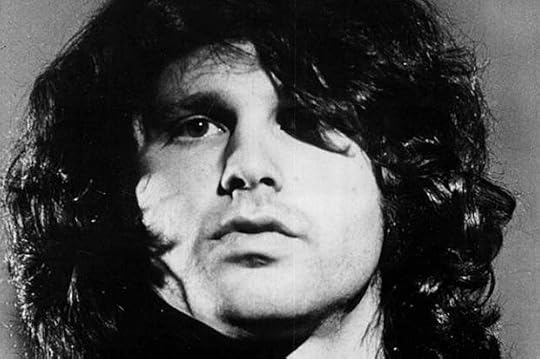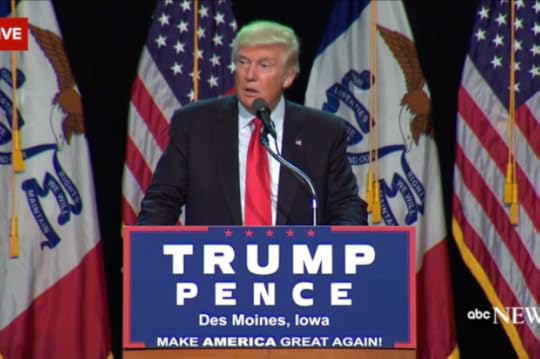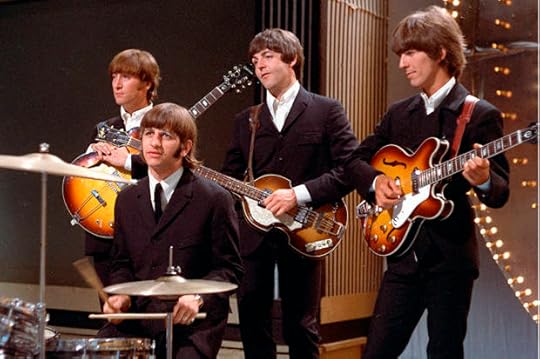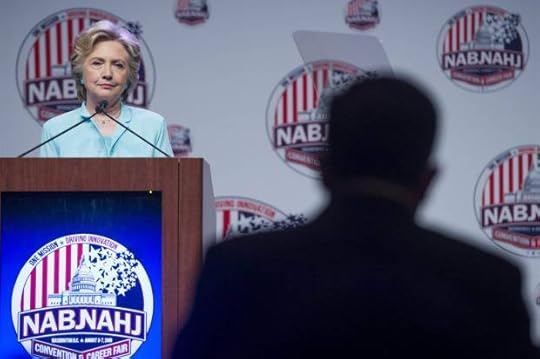Helen H. Moore's Blog, page 697
August 6, 2016
Dems, don’t get happy: Despite big media narratives of a Clinton runaway victory, 100 days is a lifetime in politics

Hillary Clinton (Credit: Reuters/Steve Marcus)
There’s a mantra I’ve carried with me throughout my career, first in radio and then print journalism. The mantra is both memorable and efficient: “Don’t get happy.”
I learned this rule when I was a 21-year-old intern for the former “Don & Mike Show,” a nationally syndicated “guy talk” radio show based in Washington, D.C. (it continues on as the “Mike O’Meara Show” podcast today). By way of background, I grew up listening to Don Geronimo and Mike O’Meara when they hosted the “Morning Zoo” show on WAVA in D.C., and, suffice to say, Don and Mike are two significant influences who led me to what I do today, certainly when it comes to my role and status here at Salon, and especially with regards to my political podcast, “The Bob & Chez Show.” But when I lucked my way into actually working for the “Don & Mike Show,” nearly 25 years ago, I quickly learned the value of not getting too comfortable in my post, as comfort — “happiness” — often breeds complacency, complacency breeds laziness, and laziness makes for horrendous outcomes.
So, don’t get happy.
This isn’t to suggest we’re not allowed to be personally satisfied by life and its intermittent success stories, but it’s always best to enjoy those moments of success, then to brace ourselves for the inevitable downside of the curve. Such is the case with the presidential election, especially now that Hillary Clinton appears to be pulling away from Donald Trump who, hour to hour, appears to be self-immolating, whether by accident or design.
Back in late April on HBO’s “Real Time with Bill Maher,” Maher loudly scolded legendary director Rob Reiner for suggesting that Hillary Clinton will easily defeat Donald Trump in November. Maher told Reiner to “shut the fuck up” because (pointing to the audience) “they won’t fucking vote!”
Maher’s anger reflected something I’ve been monitoring for years. Liberal Democrats are notoriously complacent. When it feels like their candidate might win, they have a tendency to check out. After all, Candidate X is a shoo-in, right, so why take the time off work to canvass and vote? Democrats simply get too happy. Most recently, for example, we all remember what happened in the Michigan primary when Bernie Sanders trounced Hillary in a shocking defeat that almost literally no one forecasted. One of the reasons it happened was due to Hillary voters either staying home or voting against Donald Trump in the open primary. They were too happy about Hillary’s prospects and they got burned as a result.
In fact, a couple weeks after Maher scolded Rob Reiner, Trump nearly overtook Hillary in the polls, and if the election had been held in mid-July, it’s likely Trump would’ve won. This after the Judge Curiel scandal, along with innumerable other obnoxiously controversial Trump blurtings, touched-off speculation that the GOP might replace Trump at the convention.
Funny how quickly things change. Despite a long roster of political disasters, Trump ended up in the lead just a month and a half later.
As of this writing, however, the latest polls show Hillary with a substantial lead over Trump. The most recent McClatchy poll shows Hillary with a 15-point lead, 48-33, while Nate Silver’s FiveThirtyEight forecast shows Hillary not just winning President Obama’s 2012 states, but adding North Carolina and, narrowly, both Georgia and Arizona to the map if the election were held today. As Lawrence O’Donnell pointed out Thursday evening on his MSNBC show, Bill Clinton won roughly 43 percent of the popular vote, which was resoundingly criticized as a weak plurality by the conservative media at the time, but, conversely, the 42nd president won by a landslide in the electoral college. Hillary, according to most samples, is polling at either 43 percent (NBC News poll including Gary Johnson and Jill Stein) or, as with McClatchy, five points higher than her husband’s final popular vote total. If this holds, Hillary could win 373 electoral votes — or more.
But, seriously, don’t get happy.
We’re still just under 100 days before the election, which is a lifetime in modern political terms. Almost anything can happen. The cable news channels have been known to declare candidates politically deceased, only to manufacture a “surge” narrative in the subsequent weeks, amplifying a hyper-dramatic horse-race narrative. All the networks need is a teeny-tiny incident to incite the surge, and there it is. For example, on Friday, Trump corrected himself via Twitter after having fabricated a description of video footage he claims to have seen, showing Iranian officials unloading pallets loaded down with $400 million in cash flown in from the United States. Trump ranted about this video for two days — the second day’s rants occurred after the story had been debunked by major media. But Trump’s correction on Twitter is enough to potentially spark commentators like Mark Halperin to inject a “Trump pivot” cycle into the election, with the inevitable result being a softening on Trump by centrist voters who are either undecided or leaning Hillary.
Cable news giveth, and cable news taketh away. Hillary supporters should be prepared for it.
Meanwhile, it’s likely the news cycle as well as social media trends through the next few weeks will be dominated by the Olympics, not to mention the potential for infrastructure problems in Rio to shove Trump off the front pages. With the cover of the Olympics, it’s reasonable to observe that news consumers will forget about some of Trump’s more horrendous trespasses, even though there are so many. Then again, with internationalism front and center, it might spark some all-new awfulness from Trump that’ll force his polling decline to worsen. Hillary Clinton said during her historic acceptance speech at the DNC, “There is no other Donald Trump. This is it.” Trump’s fate depends on whether he can summon the discipline to stow his ego or whether he’s stubbornly locked into his current game.
Hillary voters need to comport themselves as if she’s five points behind now in order to win by 10 points in November. The stakes of the election are too significant to get happy in early August. Trump can still win this thing.
August 5, 2016
The sneaky politics of “Suicide Squad”: A popcorn movie for the prison-industrial complex era

"Suicide Squad" (Credit: DC Entertainment)
[Note: The end of this essay contains spoilers for the ending of “Suicide Squad.”]
If the critics at RottenTomatoes are to be believed, Suicide Squad is a terrible movie with “a muddled plot, thinly written characters, and choppy directing.” (Salon’s own Andrew O’Hehir calls it “profoundly second-rate … at every level of conception and execution.”) This puts me in a distinct minority when I write: I actually loved this movie.
I thought the characters were colorful and entertaining. The plot, though a tad formulaic, was far more streamlined and coherent than a lot of the cluttered fare we’ve seen in recent superhero films (including many outside of the DC Extended Universe). Based on the screening I attended, I can attest that audiences seemed to genuinely enjoy the jokes and get swept up in the action sequences.
Most notable of all, though, is the fact that this movie had a pretty daring political subtext.
How else would you describe a movie in which, during the opening scenes, we see prison guards blatantly abuse their power so they can sadistically torture characters like Deadshot (Will Smith) and Harley Quinn (Margot Robbie)? Or how about a plot that moves forward because a sociopathic government official (Viola Davis) brags about her skill at coercing people to work against their own self-interest for the national security of the United States? What is the message of a film that depicts the state itself as, at best, incompetent, at worst, no more trustworthy than the super-powered beings they fear?
The mind wanders to our current national debate over the prison-industrial complex. America has the largest prison population in the world, with 1 out of 110 adults incarcerated in a prison or local jail and 1 out of 35 under some form of correctional control. A disproportionately large number of these are African American or Hispanic, and even Democratic presidents like Bill Clinton have been responsible for draconian legislation that has lined the pockets of private corporations that build prisons at the expense of the civil liberties of those who commit even non-violent offenses (like breaking our drug laws).
And this doesn’t even touch on the rise of #BlackLivesMatter in response to growing concerns that law enforcement officials, despite swearing to equally protect all citizens, have a history of violence toward minorities.
None of these themes are directly broached in “Suicide Squad” (aside from a passing joke by Deadshot that a government official “white people that thing” to help his daughter inflate her grades), but they’re unmistakably embedded in its overall atmosphere. The film itself feels gritty and anarchistic — a seedy group of characters in an even seedier world — and law enforcement, instead of striving to serve and protect, seems determined to act as the most ruthless and powerful gang of them all.
Viola Davis’ government agent callously disregards the lives not only of the Suicide Squad members but of ordinary people as well. When one character jokes that she is “God,” his jab works because she is indeed all-powerful — so much so that, despite her heinous actions, she alone among the major evildoers never receives her ultimate comeuppance.
This socio-political commentary is not entirely out of place in the work of “Suicide Squad” director David Ayer. His filmography is full of crime thrillers, including the acclaimed 2012 cop drama “End of Watch.” Ayers also wrote “Training Day” (2001), which, like “Suicide Squad,” depicts a world in which the difference between the hardened criminals on the streets and the law enforcement officials who claim to police them is often non-existent. Although Denzel Washington’s police officer Alonzo Harris (a role for which he won an Oscar) claims that his unorthodox behavior is a necessity born of having to control a dangerous neighborhood, it quickly becomes clear that he is simply indulging in his own most corrupt instincts because he has the power to get away with it. Ayer makes this same point in 2005’s underrated “Harsh Times,” in which Christian Bale stars as a former Army Ranger with PTSD who is disturbingly comfortable with violently abusing whatever power he is given. Both of those movies, like this one, challenge the quaint notion that there is a clear line of demarcation separating those who use violence to break the law and those who do so in the name of upholding it. From Ayer’s perspective, both groups are moral equivalents, and dramatically speaking, their tale is that of a bald power struggle rather than a battle between good and evil.
If the politics of “Batman v. Superman” were distrustful of power concentrated in the hands of individuals (a theme I analyzed in a previous article), then Suicide Squad extends that theme to look at how it can be abused when concentrated in the hands of a government. To balance this, it also establishes how the villains in the Suicide Squad — though undeniably nefarious — still have their own humanity. This seems to be a sticking point for many critics, who seem to have wanted the villains to be more unambiguously dark and sinister, but as I watched the movie I thought it made the power dynamics more complex and intriguing. Instead of allowing viewers to perceive the Suicide Squad as monsters who need to be kept in place, it forces us to see that they had hopes, dreams, loves and fears of their own — that even the most vile “scum,” as they are frequently regarded, are still human beings.
Perhaps this is why the film resonated so deeply with the audience which saw it with me. Critics may have already settled into their anti-DC bias in our comic book movie era, but I appreciate any film that upends our established understanding of social structures, even if it is only for the sake of telling a superhero story with a punk aesthetic.
Warning: Spoilers to follow. Stop reading now if you don’t want to read about the ending of “Suicide Squad.”
Not surprisingly, the movie ends in a very traditional way: the state re-incarcerates those members of the squad who haven’t died during the course of the film’s events. That said, while some of the characters are given little trinkets of compensation for their work, none are offered the full extent of what was promised to them by the government for their help. Even though “Suicide Squad” can’t allow the villains to be outright released (this would go against the grain of the comic book movie format), it establishes that the government can only keep them behind bars by breaking its word. As the characters often state themselves, there is no honor among thieves. One can easily infer the judicial system is just as much of a thief as any of the criminals.
You can admit you’ve moved on: It’s not a betrayal to outgrow your one-time favorite band

Jim Morrison (Credit: Wikimedia)
If you’ve logged on to Facebook at any point in the last week or so, you’ve probably seen the music-focused survey asking people to assess bands they hate, love, secretly love, think are overrated or underrated and enjoy seeing live, among other things. Naturally, this seemingly innocuous break from political arguing has brought about its own detractors, who proclaim that hatred of a band is uncalled for, or that there’s no such thing as guilty pleasures. (I can’t disagree with either point.) However, these brief surveys have also been a rather illuminating glimpse into other people’s record collections and listening habits. Who knew I was acquainted with so many people who think the Beatles, Foo Fighters and Rush are overrated?
On a lighter note, these posts also spawned plenty of intriguing conversations, and swapping of deep fandom secrets. In fact, one such survey prompted me to admit on one friend’s wall how much I used to like the Doors when I was in high school. I vividly recall borrowing CDs and tapes of the band’s music from my parents and listening to certain songs over and over again. In hindsight, it’s easy to see why I gravitated toward the band: Jim Morrison is a moody raconteur boasting a snaky, sinewy and mysterious voice — traits irresistible to a sensitive teenager — while musically, the group exudes rather singular poetic darkness. Yet I grew out of my Doors phase rather quickly, and can’t say I’ve actively chosen to listen to the band in years. When I do hear a song here and there, I’m struck by how nonsensical the lyrics seem, and how little magic the music seems to hold for me today.
I’m not embarrassed that I once dug the Doors, mind you. (That the group continued on at various junctures with replacement singers made me cringe more.) And I’m not broken up over the fact that I hold no emotional attachment to the band, either. The passing fancy simply illustrates the concept that you can very easily outgrow a band — relate to lyrics and obsess over albums during a certain period of your life and then move on and never look back. This unsentimental approach is more controversial than it might seem. Music isn’t necessarily supposed to be something wrung out and then discarded. From a fan perspective, letting go of important artists seems contrary to the spirit of fandom, if not disloyal or fickle. And when songs provide solace in difficult periods (or when tunes comprise the soundtrack of ecstatic times), it’s difficult to imagine even wanting them to fall by the wayside.
Plus, treating art like something emotionally utilitarian — used for a finite time and specific purpose — goes against the sacrosanct nature of creative arts, which ideally are meant to provoke enduring responses. Certainly, this isn’t saying that the arts don’t have non-emotional merits — after all, when academics study films or music, they’re often approaching them in deliberate, analytical ways in order to uncover complexities. But creators don’t work hard to produce and perfect something that’s enjoyed and then set aside. The idea is to make a mark and enact change, no matter how minor.
Complicating matters is that it’s not as easy to leave a band behind as it once was. Not only are there reunions galore — a foolproof way to dredge up old emotions, good and bad — but social media ensures old favorites are never far away, whether via vintage YouTube clips, Facebook pages or retrospective pieces. Even groups that are decisively split up (for example, R.E.M., Jawbreaker, the Smiths) still feel like vibrant entities, due to active social media and/or steady reissue campaigns. In a way, that’s comforting: Artists never really go away. But it also makes for a crowded field. There’s simply so much music being released now via so many bands (not to mention splinter and side projects) that keeping up is already overwhelming. When the current crop is competing with seasoned acts for attention, it’s almost paralyzing.
And so maybe there is something to the idea that outgrowing a band isn’t necessarily a negative or a betrayal. In a way, it’s making mental room for new favorite songs or acts. Plus, fandom isn’t an either/or proposition: Losing interest in a previously favorite band doesn’t discount the impact that band had on your life, or negate its one-time importance. In fact, it’s understandable that bands I saw first in tiny clubs who now headline major festivals won’t speak to me in the same way they did then, and now resonate with a different crowd. Not every artist is meant to be a constant presence; some are meant to come into your life at a crucial moment, make a difference and then depart. And band affection isn’t black or white, either. The relationship can evolve to resemble the comforting nostalgia of an old friendship or the rose-colored parts of a previous romance — something you look back on fondly, and occasionally revisit, but don’t necessarily dwell on daily.
In special cases, fans do grow up with an artist. Take Tori Amos, whose latest studio album, 2014’s “Unrepentant Geraldines,” touched on motherhood, feminism and identity in ways that resonated deeply with her long-time loyalists. Or there’s Wilco, which has continued to take chances and push its sound into new directions. Plus, music is a malleable art form: The catalogs of many bands reveal new insights and shadings, as fans amass age and experience. For example, I hear jubilance within the Smiths’ melancholy, while U2’s youthful vigor and optimism seems more charming now. And although the music of the Beach Boys or Beatles maybe felt simple when I was younger, today I see more nuanced, sophisticated dimensions to their songs. While it’s doubtful I’ll race to cue up “L.A. Woman” anytime soon, I’m at least open to the idea that maybe someday down the line, even hearing the Doors may turn my head in ways I never expected.
A Form Letter of Death for Paul O’Neal, the 18-year-old black teen shot in the back by Chicago police

(Credit: WLS)
I have a standard format that I use when writing about the black and brown people killed by America’s out-of-control police. I call this my “form letter of death.” I have used it many times. It helps me to maintain my mental health. The logic behind its creation is the same as why I do not watch the modern day lynching videos of black folks by America’s police. As in the case of Eric Garner, Philando Castile, Alton Sterling, and now Paul O’Neal, I know what dead black people look like. I do not need to be reminded.
It is not that I am numb to the suffering of black and brown bodies caused by agents of the American state. The police are supposed to serve and protect the public, but all too often treat people of color as enemies to be targeted in an aggressive counter insurgency campaign. Rather, I am just not surprised anymore — and how can I be, given that as of July, America’s police have now killed at least 532 people (a disproportionate number of them black and First Nations); are 3 times more likely to kill a black person than a white person; beat up and otherwise brutalize black people more than they do whites, and are quicker to shoot an unarmed black person than they are a white person.
To deny the fact that is rampant police brutality in America against non-whites, the poor, the working classes, undocumented residents, the mentally ill, and the handicapped is akin to denying the existence of gravity. One can deny that it exists, but said denial does not mean that said force has no impact on your and my life and body.
My form letter of death has the following structure.
There is a factual lede:
A recent internal report by the Chicago police revealed that its “own data gives validity to the widely held belief the police have no regard for the sanctity of life when it comes to people of color.”
I then pivot to the particulars of a given new case of police brutality:
On July 28, 2016, an 18-year-old black teenager named Paul O’Neal allegedly stole a vehicle and led police on a chase that ended in Chicago’s South Shore neighborhood. The car driven by O’Neal then hit a police SUV. Paul O’Neal fled the vehicle. The officers gave pursuit. Paul O’Neal was shot in the back and then handcuffed by the Chicago police. The body camera of the police officer who shot Paul O’Neal was not recording. The police shook hands after the chase and shooting of O’Neal. The police officer who shot Paul O’Neal also complained about likely being put on “desk duty for 30 days” because of his actions.
The use of deadly force by the Chicago police during this incident is against their training and policies.
Paul O’Neal is the 53rd person killed by Chicago police since 2013.
The video footage is so provocative that Chicago’s police department has warned of the potential for “civil unrest.”
I then offer a comment on the predictable narrative that is deployed by those who defend police thuggery and brutality against people of color, in general, and blacks, in particular:
Online and across the broader right-wing news entertainment media, white racial paranoiacs will (and already are) excuse-making and justifying the brutal killing of Paul O’Neal by the Chicago police. These defenders of police tyranny believe that O’Neal’s running from the police justified his street execution, that if black people were “compliant” and “listened to the police” they would not killed, police have a “dangerous job” and are often in “fear of their lives” so they must be given “the benefit of the doubt.” “Blue lives matter” and “we must wait for all the facts to come out before rendering judgment.” The black family is “broken” and “where is the outrage about ‘black on black crime.’” And of course, the new version of the racial slur “nigger” will be used as Paul O’Neal is described as a “thug.”
I then reject these racist, foolish, empty, and banal deflections:
The police are not supposed to act like brigands or criminals. This is the foundational principle that must govern how we discuss police brutality in the United States.
To this I add:
In this moment, we march and say “Black Lives Matter” because it is abundantly clear that since before the Founding of the United States, and through to the present, such a claim is not true. Black lives have been useful for America as laborers, entertainers, slaves, soldiers, artists, musicians, as objects of sexual desire, or the occasional political leader, but the full and equal humanity of black people, both as a group and as individuals, is something that the White Gaze and White America still very much doubts.
Next, I locate a given new incident of police brutality against people of color within the continuities of American history and color line:
There is tedium to the pain caused by police brutality against black and brown Americans.
The “national conversation” on race and police violence is not new.
In 1963, Dr. Martin Luther King said in his iconic “I have a Dream Speech” that, “There are those who are asking the devotees of civil rights, ‘When will you be satisfied?’ We can never be satisfied as long as the Negro is the victim of the unspeakable horrors of police brutality.”
In 1965, Robert Kennedy made it clear that, “To many Negroes, the law is the enemy. In Harlem, in Bed-Stuy, it has almost always been used against them.”
As far back as 1904, Booker T. Washington warned, “If the law is disregarded when a Negro is concerned, it will soon be disregarded when a white man is concerned…”
Those white Americans (and some others) who claim shock and surprise at each new incident of police brutality against those fellow Americans whose skin color is different from theirs are drunk on denial and live a life colored and distorted by white privilege.
I then make what should be, at least for decent and thinking human beings, a troubling observation about American culture.
Police brutality and violence against marginalized groups continues unabated because on a fundamental level (white) American society supports it. Police thuggery and violence — and the racist and classist criminal justice system for which the police are the frontline enforcers—are not a bug or a glitch in American society. They are features.
There is then a closing of sorts.
Paul O’Neal is the latest human entry in the Black Necropolis in the Age of Obama. He will soon, as is the routine in America, be joined by other black and brown bodies shot dead by America’s police.
Now, I would like to add a new part to the form letter of death I use for writing about black and brown people killed by America’s police.
I offer a question. What of our collective conscience? And for all of the platitudes about “American Exceptionalism” where is the shame and embarrassment? Are “we” not better than this?
“I don’t throw babies out. Believe me, I love babies”: Donald Trump on baby-gate

During his town hall speech in Des Moines, Iowa, on Friday, GOP nominee Donald Trump addressed an incident at a rally earlier this week, in which he asked a mother to remove her crying baby from a venue in Ashburn, Virginia.
Trump recalled the baby was “crying like you wouldn’t believe. The baby could have been [Luciano] Pavarotti,” the late Italian opera singer.
“The whole place laughed, we had a good time,” Trump said, contrasting the mood in the room with the press’s reaction: “The press came out with headlines, ‘Trump Throws Baby Out of Arena.'”
“You know how terrible that is?” he continued, alleging the media — which he’s consistently demonized on the campaign trail — inflated the narrative. “It’s a lie. And they know it’s a lie.”
“I don’t throw babies out,” he added. “Believe me. I love babies.”
WATCH: Remember the crying baby from earlier this week? Here's @realDonaldTrump's take on it –> https://t.co/pZJIq9g9ln
— Ali Vitali (@alivitali) August 5, 2016
WATCH: Reporter trolls U.S. State Dept. after Israeli forces steal Palestinian child’s bike

An Israeli occupation police officer stealing the bike of an 8-year-old Palestinian girl in the occupied West Bank (Credit: YouTube/BTselem)
In a surreal moment in the daily press briefing on Thursday, a reporter asked the U.S. State Department spokesperson about the theft of the bicycle of a crying 8-year-old Palestinian girl by Israeli occupation forces.
The State Department spokesperson responded robotically with a detailed description of Israel’s “security concerns,” its “strong democracy” and its “ironclad” alliance with the U.S.
A widely circulated video published by an Israeli human rights organization this week shows Israeli police officers taking the young girl’s bike and throwing it in nearby bushes.
The video was taken in late July in the Palestinian city Hebron, in the occupied West Bank. It was published by B’Tselem, The Israeli Information Center for Human Rights in the Occupied Territories.
The Israeli officers later told investigators they took the child’s bike in order to protect her.
The incident highlights the daily oppression endured even by young Palestinian children living under Israel’s illegal 49-year military occupation.
Another report released this week by B’Tselem details how, on July 19, Israeli forces shot a black sponge round at the chest of a 10-year-old Palestinian boy, killing him.
In the U.S. State Department daily press briefing on Thursday, Aug. 4 (video below), journalist Said Arikat, the Washington bureau chief at Palestinian newspaper Al-Quds, asked spokesperson Mark Toner about the incident.
“Should Israel compensate this little girl for the bicycle?” the reporter asked, 35 minutes into the briefing.
The State Department spokesperson said he could not answer the question. He instead talked about “the tensions that exist in Israel regarding security and security concerns.”
“But you subsidize Israel to the tune of billions of dollars,” Arikat replied, alluding to the $3.1 billion in unconditional military aid the U.S. gives to Israel every year.
“Should you deduct $100 from the $40 billion or so that you’re about to give Israel for the next 10 years, and say this is to replace the bicycle?” he asked.
Toner responded with a long discussion of “Israel’s national security interests” and the U.S.’s “ironclad” alliance with Israel, calling it “a strong proponent of democratic values in the region.”
He then briefly added that he is “not aware of any efforts” to compensate the Palestinian girl.
Watch the bizarre interaction below. A transcript of the discussion follows the video.
SAID ARIKAT: Last week, an Israeli soldier in the occupied city of Hebron roughed up a little Palestinian girl on a bicycle, and then he took her bike and destroyed it. My question to you is very simple: Should Israel compensate this little girl for the bicycle? Very simple.
MARK TONER: So I don’t know that that’s a question we necessarily should answer from the podium of the State Department, but what I’ll say is we understand the tensions that exist in Israel regarding security and security concerns, but – and I’ve seen the video; I know what you’re talking about – it’s also legitimate to say that what’s portrayed in that video is concerning and raises emotions on the part of many people who see it, and that any security forces – and I’m talking about not just Israel’s, but any security forces around the world – have a difficult job. We understand that they have to balance a lot of factors in carrying out their duties, but they also need to be aware of how their actions portray what they’re doing and the reasons behind what they’re doing to the rest of the world. So that’s a question for the Israeli authorities to speak to. I’m just offering my opinion.
SAID ARIKAT: But you subsidize Israel to the tune of billions of dollars.
MARK TONER: We do.
SAID ARIKAT: Should you deduct like $100 to pay for that bicycle? It’s a serious question.
MARK TONER: No, I —
SAID ARIKAT: Should you deduct $100 from the $40 billion or so that you’re about to give Israel for the next 10 years, and say this is to replace the bicycle?
MARK TONER: Said – so I spoke about this a little bit yesterday. Our security relationship with Israel is important both to Israel’s national security interests as well as our own, as well as the region’s, and it’s vital that we maintain that close cooperation. And, frankly, that relationship, as I said yesterday, is ironclad. Israel is a strong democracy in the region and a strong proponent of democratic values in the region. We’re looking at this incident. I agree that, again, for those who watched the video, I can see where it raises emotions and raises concerns. And what we’ve always said – and that bears – that is true for Israel’s security forces or Israelis, as well as for Palestinians – is that all sides need to bear in mind and take – or make efforts not to escalate tensions and be aware that their actions could escalate tensions in what is already an overly tense situation. And I think that’s our message.
SAID ARIKAT: So you don’t – you will not urge Israel to compensate this little girl —
MARK TONER: I’m not aware of any efforts on that part.
SAID ARIKAT: — to the tune of $100 for – to pay for the bicycle?
MARK TONER: I’m not aware that we – and I’m not even sure we could do that.
Why “Revolver” still matters: The 50th anniversary of a Beatles masterpiece

The Beatles (Credit: AP)
Even if you scorn Boomer myth-making, the 50th anniversary of “Revolver” — perhaps the Beatles’ best album — is a big deal. It not only sent the band in a new direction, it showed new possibilities in rock music. Look at the state of rock music in the 21st century — when so much of popular music is about artfully recycling existing tropes and styles — and it can be hard to see what the fuss was about. But the album was groundbreaking for a bunch of reasons, and it’s aged better than almost any of the great records of the era.
One way that “Revolver” immediately stood out was its eclecticism. The album that preceded it, “Rubber Soul,” saw the band mostly in acoustic-folkie mode, and the one that followed it, “Sgt. Pepper’s Lonely Hearts Club Band,” was mostly expansive, psychedelic, and orchestrated. Both are masterpieces. (The hype around “Sgt. Pepper’s” has led some to dismiss it, but go listen to it sometime — even overlooking the backstory and concept-album pretensions, it’s packed full of good tunes.) But “Revolver” shows a complex band stretching all over the place: Between an Indian tune, chamber pop, acid-influenced psychedelia, muscular rockers, and everything in between, the album is so wide-ranging that, with the inclusion of one more genre, it would probably not have held together.
Part of the reason “Revolver” worked so well was that the on-again, off-again battle between the band’s three songwriters has reached a point of productive detente. The Beatles had begun as John Lennon’s band, and would soon become Paul McCartney’s: Drugs and indifference and general orneriness would take Lennon far away from the collaboration that a rock group needs. McCartney’s curiosity and squareness — his avoidance of hard drugs, his interest in contemporary art and experimental music, his earnest band diplomacy — was making him more sophisticated and essential with each album. But both were still at the tops of their games and working together at least some of the time.
The emergence of George Harrison complete the perfect chemistry: Frustrated over the years by being pushed aside, the guitarist saw three of his songs — the opener, “Taxman,” the Indian “Love You To,” the moderately dissonant “I Want To Tell You” — sneak onto the album.
Throw in Lennon’s rocking “And Your Bird Can Sing” and his psychedelic breakthrough “Tomorrow Never Knows,” and McCartney’s “For No One” and “Eleanor Rigby,” and you have a collection of timeless songs even with an entire side to go.
As lively and inventive as the early Beatles albums were, “Revolver” is also the one that saw them unleashed in the studio. Abbey Road was quite primitive by the standards of our day, and less sophisticated than studios in California. But producer George Martin and Geoff Emerick went out of their way to make instruments sound uncanny, to allow Lennon to indulge strange ideas (a microphone, wrapped in a condom, submerged in water), to incorporate tape loops and unorthodox instruments into the sound.
“Revolver” was so sonically advanced, in fact, that the band stopped playing live around the time of its recording: They saw no way to play its songs outside the studio. In some ways, the process deepened an insularity that would hurt the band creatively and personally.
“Revolver” isn’t perfect. McCartney’s chipper “Good Day Sunshine” and his Motown-inspired “Got to Get You Into My Life” are not among the band’s best music: They’re musically derivative and emotionally forced. Despite its charm, “Yellow Submarine” may not quite fit on the album. “Revolver” would be too grim and brooding with all three of these numbers removed, but they tear its fabric a little bit.
But it’s still a wonder. Part of what’s odd about “Revolver” is that its eclecticism and psychedelia didn’t last long. Music and culture was changing so fast in the ‘60s: Bob Dylan released the forward looking “Blonde on Blonde” the same year, and the Rolling Stones briefly dabbled in psychedelia. But by 1968 and ’69, musicians were turning back from the restlessness of “Revolver.” The Stones were in retro-country mode, as was Dylan. Between The Band and Joni Mitchell and Van Morrison, much of the most talented musicians were looking backward. By 1970, Jimi Hendrix — who seemed the most likely to extend the Beatles’ experimentation — was dead.
It’s also safe to say that “Revolver” was the album that kids who grew up in the ‘70s and ‘80s grew into, once their pre-pubescent fascination with earlier, less-challenging Beatles albums wore off. It was the record they were listening to as teens, and it was the one that, possibly more than any other album, was a touchstone for the indie-rock movement of the ‘90s. (Just try to imagine the Stone Roses or Oasis or Pavement or Radiohead without it.)
The Beatles experienced a backlash in the United States just before the release of “Revolver” because of Lennon’s remark that the band was “more popular than Jesus now.” More popular or not, as great as their earlier work has been, it was “Revolver” that made then deities.
“We encourage you to do this more often”: Hillary Clinton finally holds a “press conference” — sort of

A member of the media asks Democratic presidential nominee Hillary Clinton a question during the National Association of Black Journalists(NABJ) and National Association of Hispanic Journalists(NAHJ) joint convention in Washington, DC, August 5, 2016. (Credit: SAUL LOEB / AFP - Getty Images via NBC News)
Hillary Clinton has not held a formal press conference in 244 days, but on Friday afternoon she took a range of questions from journalists of color.
“On behalf on all us we encourage you, to do this with more reporters across the country,” The Washington Post’s Ed O’Kefee told the Democratic presidential nominee during a rare question-and-answer session at a joint convention of the National Association of Black Journalists and the National Association of Hispanic Journalists on Friday.
Clinton has notoriously shied away from the press during her latest presidential run, joking about her reclusive rapport with reporters during one of her last appearance before a group of journalist last winter.
“No more secrecy, no more zone of privacy,” Clinton said at a journalism awards dinner to honor the late New York Times reporter Robin Toner in 2015. “After all, what good did that do me?”
“You’ll find a simple nondisclosure agreement,” Clinton then joked to reporters, telling them to search under their seats.
“My attorneys drew it up. Old habits.”
But after months of hounding from her political opponents and the traveling press core, Clinton finally took several questions Friday. After a short speech to the over 1,000 journalists of color gathered in the nation’s capitol, Clinton’s first queries from the press dealt with her hesitance to speak with them.
“Keep holding all of us accountable,” Clinton told attendees. “I do have this old-fashioned idea: When you run for president, you ought to tell the voters of America what you would do as president. So I am going to keep telling you what I would do because I want you to hold me accountable, press and citizens alike.”
The former secretary of state said journalists have “special responsibility to our democracy in a time like this.”
“As Ida B. Wells once said,” Clinton started, citing the suffragist and prolific chronicler of lynchings in America. “‘People must know before they can act, and there is no educator to compare to the press.'”
“It is a badge of honor when Jorge Ramos gets thrown out of a press conference for challenging Donald Trump,” Clinton told the crowd, praising the Univision newsman for standing up to Trump and “reporting what he says.”
“And yes, he also talks about curtailing press freedom as well,” Clinton said of her Republican rival who has banned whole newspapers and media outlets from covering his campaign events.
“We need to stand up as a country and say, ‘Donald Trump doesn’t represent who are are and what we believe,’” she said.
“As Jorge said, the best journalism happens when you take a stand, when you do not justice. I hope you will keep calling it like you see it,” Clinton said.
“I believe with all my heart that America is better than this,” Clinton concluded. “America is better than Donald Trump.”
You can watch her full appearance at the event below:
Newly released videos show fatal police shooting of unarmed black teen in Chicago

The Independent Police Review Authority on Friday released dashboard and body cam video of Chicago police officers fatally shooting unarmed 18-year-old Paul O’Neal.
The O’Neal family — as well as a small group of activists and representatives — saw the footage at IPRA headquarters before it was released to the public at 11 a.m.
“This is amazing to me, how these officers come in our neighborhoods and treat us like savages,” O’Neal family spokesperson, Ja’Mal Green, told a local ABC affiliate. “The way Paul was treated was ridiculous.”
O’Neal, a black man, was shot in the back last Thursday by officers in Chicago’s South Shore neighborhood. Police were responding to reports of a vehicle stolen from the Chicago suburb, Bolingbrook, according to ABC7.
Three officers have subsequently been stripped of their police powers. The O’Neal family filed a federal civil rights lawsuit against the department on Monday.
In the video footage, police fire several shots at a convertible Jaguar, which then slams head-on into a police car. The driver, O’Neal, exits the vehicle and flees into a backyard, where he’s fatally shot.
(Warning: The footage is, at times, graphic.)
Officers on scene can be heard saying, “[Don’t] fucking shoot at us” as they order O’Neal’s hands behind his back.
Donald Trump and the Tea Party myth: Why the GOP is now an identity movement, not a political party

Donald Trump (Credit: AP/Kevin Hagen)
In 2009, shortly after America elected its first African-American president, the Tea Party was born. The movement was sold as a grassroots explosion of conservatism. Middle America had had enough. Big government spending was out of control. The debt was a national crisis. We were bankrupting future generations of Americans. That none of these people were troubled by the previous 8 years under George W. Bush was more than a little suspicious. After all, it was Bush who dumped trillions of dollars into unwinnable wars. It was Bush who added nearly $6 trillion to the debt. It was Bush that signed the first bank bailout.
But when Obama was elected, fiscal conservatives found religion.
It was always clear the Tea Party had nothing to do with policy or ideology. It wasn’t about spending or ObamaCare care or entitlements or state tyranny. This was a myth propagated by the silent financiers of the movement. The Tea Party was mobilized by the groups Americans for Prosperity and Freedom Works, both of which were financed by the Koch brothers. Indeed, these groups were formerly a single organization called Citizens for a Sound Economy, which was founded in 1984 by the Kochs.
The Kochs created the first national website for the Tea Party and used the group to promote their Randian free market fetishism. But the movement itself had almost nothing to do with economics. On the ground, it was obvious this was about something broader, more fundamental. These were mostly white people (89 percent, in fact) reacting against cultural change. 75 percent of Tea Partiers were 45 years old or older, and 60 percent were men. They were united by a nebulous cocktail of ethnocentrism and white nationalism. A black man was president and they suddenly wanted to “Take the country back.”
The sentiments let loose by the Tea Party never went away. They’ve festered for eight years. Last year, Donald Trump read the political winds and set sail on this sea of cultural angst. Lest we forget, he launched his campaign by embracing birtherism, and he rocketed to the top of the Republican polls. “This is the day we take our country back,” he told supporters back in February. It was never explained what that phrase meant, but the slogan implied the answers. For the “silent majority” at least, it was well understood.
Trump’s nomination has brought the GOP’s race problem to a head. The Tea Party is the Republican Party. The fringe is now the base, and the base is neither conservative nor ideological. As I noted Thursday, political science research shows that Republicans, despite being more likely to hold racist beliefs, have rarely voted on the basis of those beliefs – not consciously in any case. But that changed with Trump. Racial enmity appears to be the motivating factor among his supporters. The only other comparably strong predictor of Trump support is anti-Muslim attitudes. There is, in other words, no pretense of conservatism. Trump voters are impelled by race and nativism.
If you’re not convinced ideology is irrelevant, consider Trump’s new infrastructure plan. As my colleague Simon Maloy pointed out, it’s a trillion dollar government stimulus program. Conservative writer Jonathan Tobin rightly compared it to Obama’s stimulus package, only bigger and, presumably, more socialist. In an appearance on the Fox Business Network, Trump claimed that Hillary Clinton’s $275 billion dollar infrastructure plan was only “a fraction” of what’s needed. Of course, he’s been short on specifics, and to the extent that he’s explained his proposal, it makes no sense. The point, though, is that none of that matters. You won’t hear Trump voters complain about it and you won’t hear his Republican apologists calling him a liberal statist. Once again: ideology has been reduced a prop.
If Tea Party conservatives (most of whom support Trump) gave a damn about spending, they’d denounce this “big government” monstrosity. But their fealty to Trump is untouched by policy. If Obama were to propose anything like this, cries of tyranny would echo at Trump rallies. With Trump, however, it’s a non-issue.
Trump’s ideological heresy goes beyond spending. Recall his open hostility to free trade, a sacrosanct principle among conservatives. If Trump wasn’t riding this wave of racial resentment, I suspect we’d hear a lot more about his protectionism. But the base hardly noticed it. They don’t care about free trade any more than they do limited government, which is to say they don’t care about conservatism. Trump may be ideologically incoherent, but he’s signaled that he’s with his supporters on the cardinal issue – racial identity. Everything else is noise.
Now the Republican establishment has a crisis it can’t contain. By bringing the racial resentment out into full view, Trump has cut through the veneer of conservatism that concealed the driving force of Republican politics.
The cultural hysteria is all that’s left.



